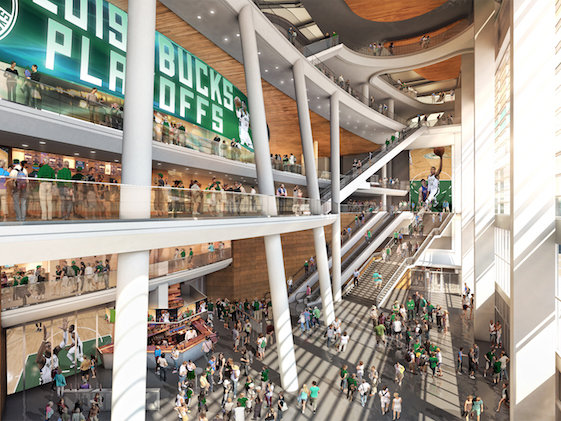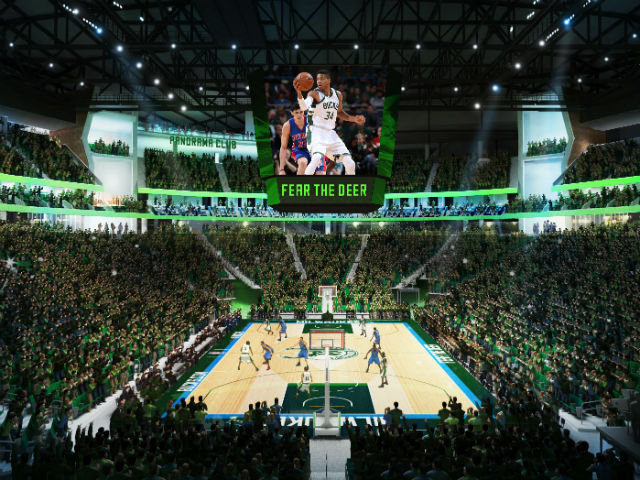As Milwaukee looks to build its third major sports arena in 30 years, we should view dramatic changes in pro sports as a big part of the project landscape.
My experience having observed, covered and participated in local public projects in the last three decades shows that some things have really changed and some things remain the same. So, let's take a quick look.
What's changed most in Milwaukee since the Bradley Center (1987) and Miller Park (2001) opened: Increased Downtown development and residents, major Menomonee Valley development and the world-renowned Santiago Calatrava-designed addition to the Art Museum on the lakefront.
What is the same in Milwaukee: We have a passionate community and strong fan support, but there is big resistance to change causing political and community gridlock.
What's changed in pro sports: More money, revenue sharing and global exposure.
What's the same in pro sports: Very little except for a few of the rules.
So, how does the arena project face changes looking forward while learning from the past?
The Bradley Center may seem like a clean, current and well operated arena, but it has unfortunately become obsolete by current NBA and pro sports standards. However, we have seen it help create significant commercial and residential Downtown development, as well as impact projects to the west like the Menomonee Valley, Marquette University and the Pabst Brewery.
Even with the generous private donation for the Bradley Center, Milwaukee still struggled to get the facility built back in the 1980s. The Miller Park funding and construction process was another major battle while many other local projects lack leadership and vision. So, with a few exceptions, Milwaukee is pretty much the same place it was three decades ago.
Factors beyond local control have made a franchise like the Bucks a much bigger deal and attractive than it was in the past. Just look at how the value of the team exploded during Herb Kohl's ownership from $18.5 million in 1985 to $550 million when recently sold to Wes Edens and Marc Lasry. Even now, the franchise value continues to increase to as much as $600 million according to Forbes.com.
NBA total current revenues are in the $5 billion range compared to $118 million in 1982, while the Bucks made a net profit of almost $15 million last year according to a report from Grantland.com. Those huge numbers only project to keep growing.
Professional sports, like the NBA, make their money on a combination of ticket sales, merchandise, licensing, sponsorships and, of course, television contracts, which are all now more global than local. About 20 percent of NBA players are now foreign-born compared to five percent in the early '90s. The Bucks even participated in the NBA's global outreach, playing a game in London earlier this season.
The global growth of pro sports make franchise locations and game attendance less important than 30 years ago. This is also the reason that out-of-town billionaires own franchises in cities like Milwaukee. They run a team from New York, Los Angeles or anywhere else as part of the prestigious NBA or MLB club, while making occasional Milwaukee visits to watch their investments grow.
For metro area whose population has declined or held steady in recent years, Milwaukee has supported its pro sports teams.
Bucks' fans have not been known for their big numbers when it comes to attendance at the Bradley Center. In fact, last season (2013-14), the Bucks ranked last in the NBA for total attendance at 552,967 and in per game attendance at 13,487. With increased success this season, Bucks' attendance totaled 577,406 with a 14,805 average with one final home game tonight.
That's why it might be surprising that Milwaukee fans rank near the top of the NBA when it comes to per capita attendance. Small market teams like Utah, Oklahoma City, New Orleans, Memphis and Indianapolis most strongly support their teams on that basis, while big markets like New York, Chicago, Philadelphia and Atlanta are near the bottom. However, the league can thrive due to growing globally and sharing revenue between larger and smaller markets.
The NBA of 2015 and beyond is vastly different and bigger than the NBA of 30 years ago. So, if today's Milwaukee powerbrokers can get past their politics and egos to break the gridlock, it's really a matter of spending local money to bring in global money on the proposed arena project.
Marotta's memory: I was fortunate to briefly meet and work with Marc Marotta years ago. He was as nice and genuine as everyone is recalling after his recent passing. I can't imagine a new arena being built here without a decent tribute to Marotta and his many contributions to Milwaukee. A classy youth basketball court similar to Helfaer Field at Miller Park might be an appropriate honor.
Mike Morgan rides retro, whether on his 1976 Harley Aermacchi 250 or Heritage Softail. Mike has been a motorcyclist since 2001 having ridden in Sturgis, Daytona Beach, the California coast, New England and everywhere in between, including in the last three Milwaukee Harley Anniversary parades.
Mike worked in communications and marketing at Harley-Davidson for more than 12 years, writing and editing all kinds of content, including award-winning media kids in 2009 and 2012. He had ridden the Harley several times before Brewer games at Miller Park, and ran in one of the last sausage races at the old County Stadium when he was Communications Manager for the Stadium District Board.







